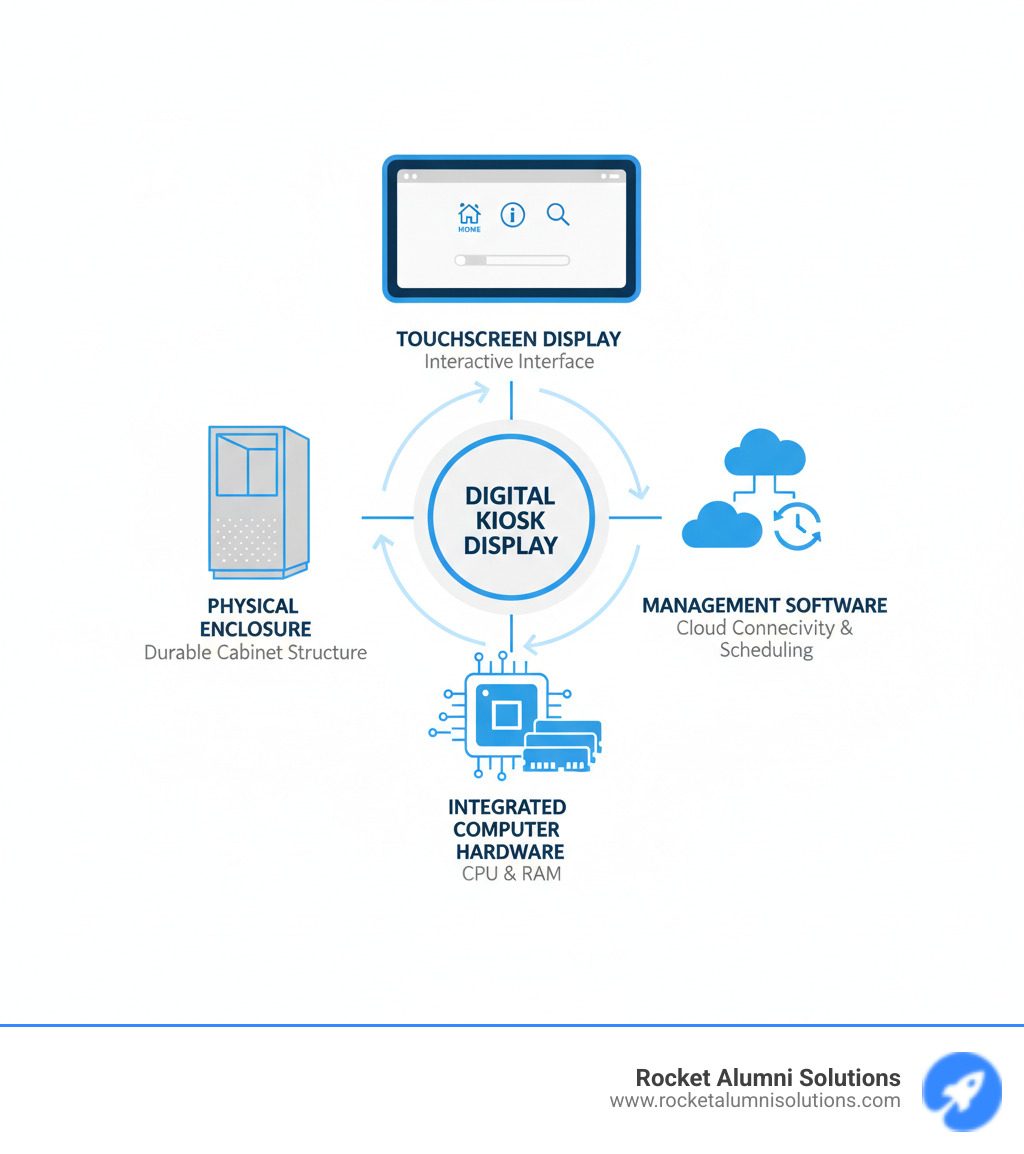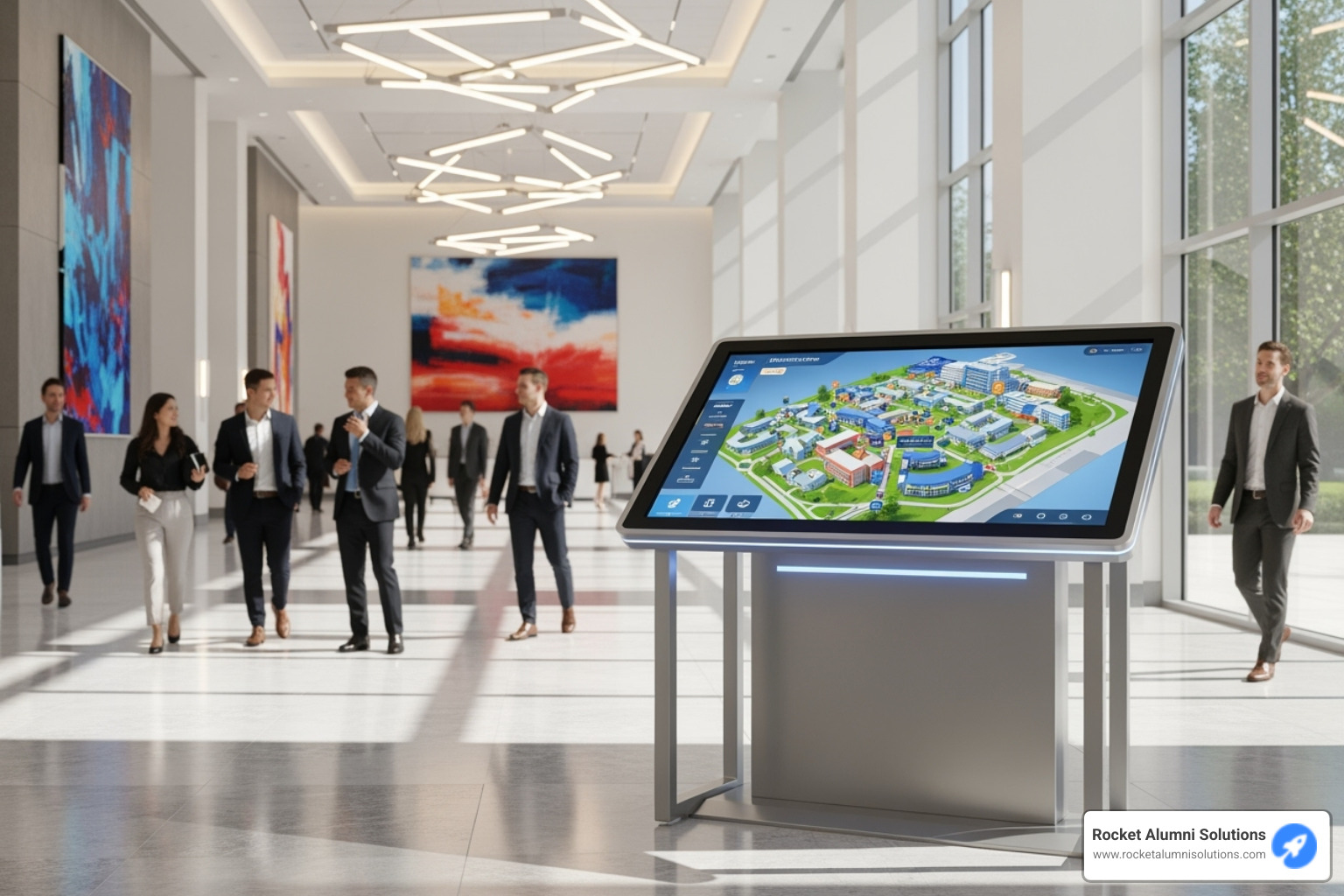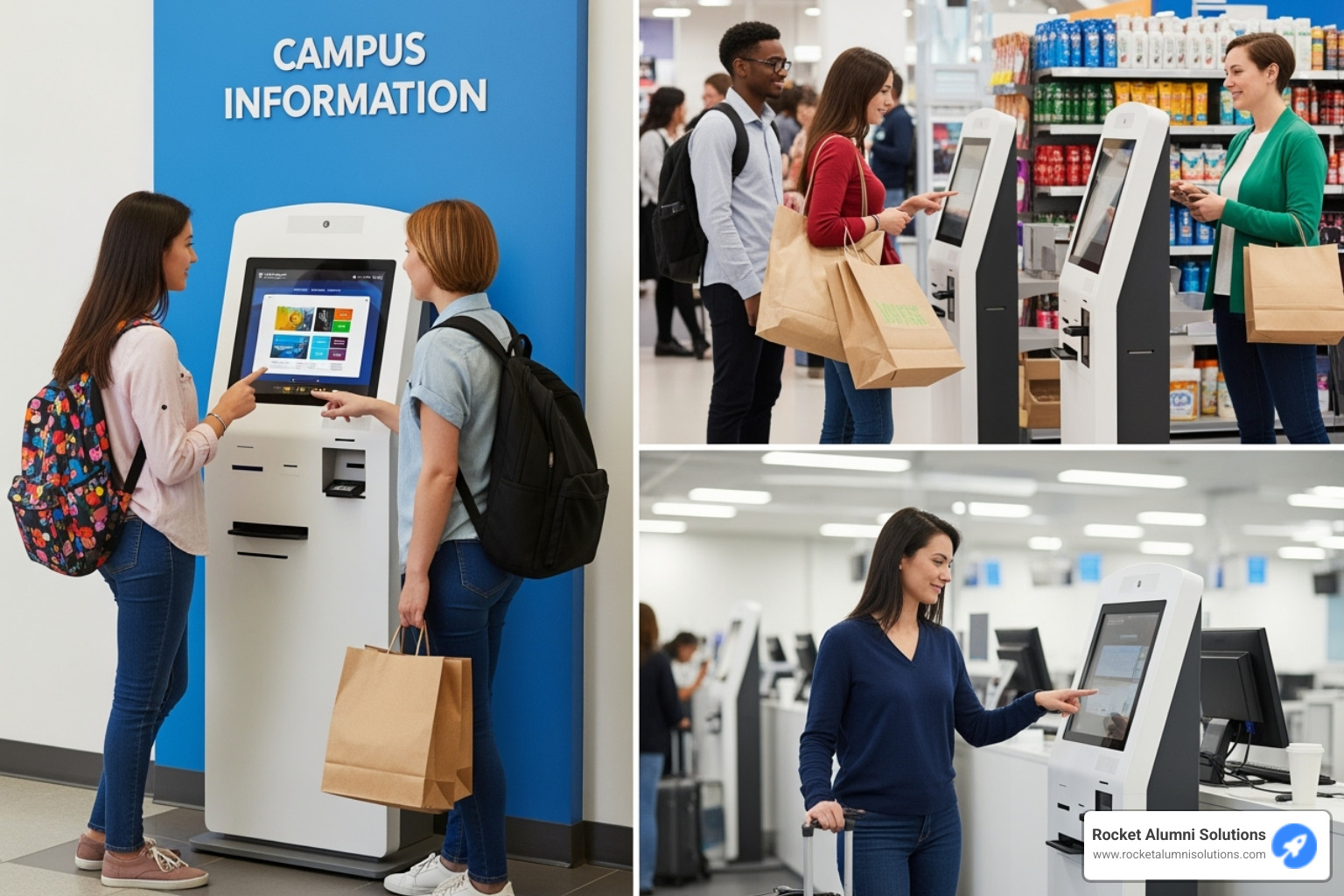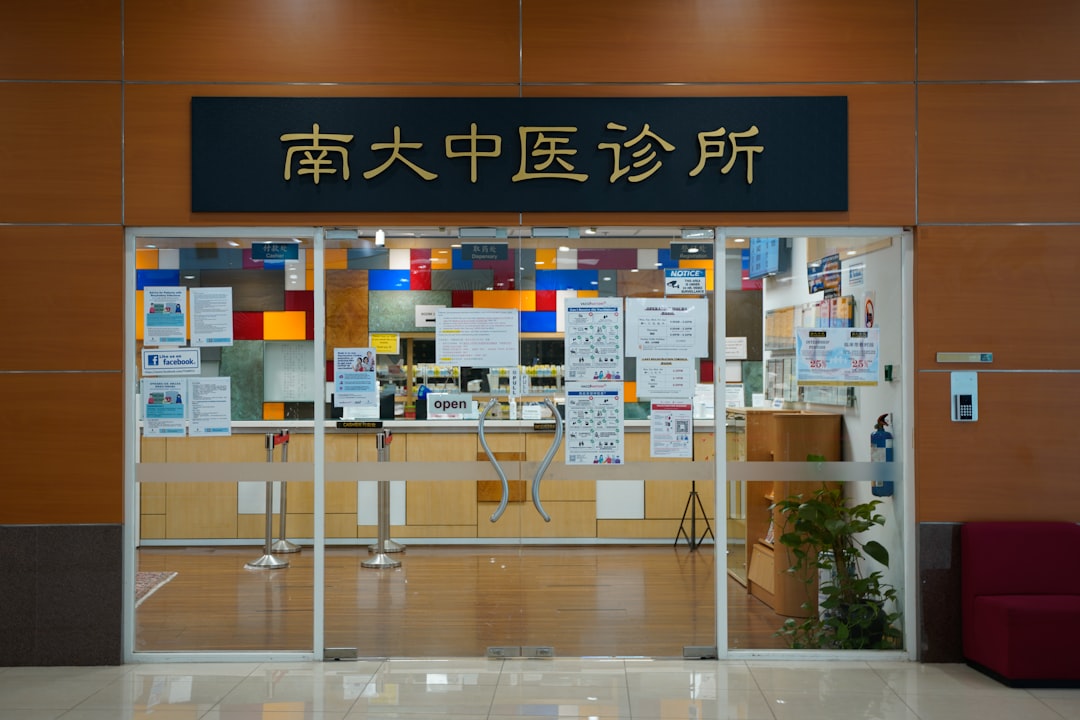Why Digital Kiosk Displays Are Changing Business Operations
Digital kiosk display solutions are freestanding interactive screens that provide information, services, and transactions without requiring staff assistance. These self-service terminals consist of four core components: a touchscreen display, integrated computer hardware, a durable physical enclosure, and management software for content control. Businesses deploy them to reduce wait times, cut labor costs, and create a modern brand image while customers gain immediate access to information, ordering, wayfinding, and checkout services.
What to Look For When Buying:
- Screen Size & Resolution: 21.5" to 55" most common; Full HD (1920x1080) minimum, 4K for premium applications
- Touch Technology: Capacitive for responsive multi-touch; IR for durability and large screens
- Connectivity: Wi-Fi, Ethernet, or Power-over-Ethernet (PoE) for flexible placement; 4G for outdoor locations
- Enclosure Type: Freestanding, wall-mounted, or portable A-frame; outdoor models need weatherproofing (IP65+ rating) and high brightness (500+ nits)
- Software: Cloud-based Content Management System (CMS) for easy remote updates, scheduling, and analytics
- Customization: Vinyl wraps, custom enclosures, and branded UI to match your organization's identity
The global interactive kiosk market is expected to reach $42.8 billion by 2030, growing at 6.33% annually, as more organizations recognize that these displays improve customer experience while streamlining operations. From self-ordering in restaurants to wayfinding on corporate campuses, digital kiosks deliver both immediate satisfaction for users and measurable ROI for businesses.
I'm Chase McKee, founder of Rocket Alumni Solutions, and I've spent years helping schools and organizations implement digital kiosk display solutions for donor recognition, athletic halls of fame, and interactive campus directories. Through countless deployments, I've seen how the right kiosk—paired with intuitive software—transforms how communities engage with information and each other, often increasing donor retention by over 25% when recognition becomes interactive and personal.

Essential digital kiosk display terms:
The Core Benefits of Integrating Digital Kiosk Displays
When you walk into a space with a sleek digital kiosk display, something feels different. The atmosphere feels more alive, more modern, more efficient. That's no accident—these interactive displays are quietly revolutionizing how businesses connect with customers and how organizations run their day-to-day operations.
After helping hundreds of schools and organizations implement these systems, I've seen how the right kiosk transforms not just operations, but the entire experience for everyone who interacts with it.

Improved Customer Experience
Think about the last time you stood in a long line, watching the minutes tick by. Frustrating, right? Digital kiosk displays eliminate that frustration by putting customers in control of their own experience.
Picture a busy café during morning rush hour. Instead of waiting while someone ahead orders a complicated drink with five modifications, customers can walk up to a kiosk, browse the menu at their own pace, customize their order exactly how they want it, and pay—all in under a minute. This immediate satisfaction and reduced wait time transforms what could be a stressful experience into a pleasant one.
But it goes deeper than speed. When people interact with a touchscreen, they're actively engaged rather than passively waiting. They can explore options, compare choices, and make decisions without feeling rushed by a line forming behind them. This sense of user control creates a more positive emotional connection with your brand.
We've seen this play out beautifully in educational settings too. When alumni visit a campus and can browse an interactive hall of fame at their own pace, searching for their own achievements or reminiscing about teammates, they're not just viewing information—they're having a personal experience that strengthens their connection to the institution.
Increased Operational Efficiency
Here's where the business case for digital kiosk displays becomes impossible to ignore. These systems don't just make customers happier—they make your entire operation run smoother and more profitably.
The most obvious benefit is cost savings on labor. When a kiosk handles routine tasks like answering frequently asked questions, processing orders, providing directions, or checking people in, your staff can focus on situations that actually need a human touch. You're not replacing people—you're freeing them to do more meaningful work that builds relationships and solves complex problems.
But the efficiency gains go beyond staffing. Remember the old days of printed posters and signage? You'd design them, print them, ship them, install them, and then—when something changed—remove them and start all over. With a digital kiosk display, you update content instantly from your computer or phone. Launch a new promotion? Update it across all your displays in seconds. Need to change hours for a holiday? Done before you finish your coffee.
These streamlined processes add up to serious savings. No printing costs, no shipping delays, no installation crews, no disposal fees. Just immediate, flexible communication that adapts as quickly as your business needs demand.
Modern Brand Image
We judge books by their covers, and we judge businesses by their environments. Fair or not, that's human nature.
A digital kiosk display sends an immediate message: this organization is forward-thinking, tech-savvy, and invested in providing excellent service. It creates a sophisticated ambiance that lifts your entire space, whether that's a retail store, a university lobby, or a corporate office.
This isn't about following trends for trend's sake. It's about meeting people where they are. Today's customers—whether they're students, shoppers, or visitors—expect digital interaction. They've grown up with smartphones and touch interfaces. When your space reflects that reality, it feels intuitive and welcoming.
The innovative perception this creates gives you a real competitive edge. Two similar businesses side by side—one with dated signage, one with crisp digital displays—will be perceived very differently. The digital option looks more established, more trustworthy, more worth engaging with.
Effective Communication
Here's something that surprises many organizations: a digital kiosk display isn't just a customer-facing tool. It's one of the most powerful employee communication platforms you can deploy.
Think about traditional bulletin boards or static signs. They show one message, period. Maybe it's relevant today, maybe it was relevant last month, maybe nobody's quite sure anymore. Digital displays let you deliver dynamic messaging that changes throughout the day, throughout the week, or in response to real-time events.
Need to announce an emergency closure? Push the message instantly. Want to highlight employee achievements? Rotate through recognition messages. Sharing company values, safety reminders, or upcoming events? Schedule them to appear at optimal times when people are most likely to see them—a concept called dayparting.
For customer-facing applications, this means your real-time updates keep pace with your business. Menu changes, product launches, event schedules, wayfinding information, weather alerts—all of it stays current without manual intervention.
And because modern kiosks are often portable or easy to relocate, you can move them to where communication is most needed. Setting up for a special event? Bring a kiosk. High-traffic area changing seasonally? Move your displays to match foot traffic patterns.
This kind of flexibility transforms how information flows through your organization, creating what effectively becomes an employee information hub that keeps everyone aligned and informed—while simultaneously serving customers with the exact information they need, exactly when they need it.
Exploring the Types of Digital Kiosk Displays
The world of digital kiosk displays is surprisingly diverse, with options designed for nearly every business need and environment. Understanding the different types available helps us find the perfect match for our organization's goals and space.
Interactive vs. Non-interactive
The most fundamental distinction in digital kiosks is whether they're interactive or non-interactive. Non-interactive displays, sometimes called static digital signage, function primarily as broadcast tools. They're excellent for showing advertisements, announcements, or videos—basically any content that needs to be seen but not touched. Think of them as the digital equivalent of a poster, but with the ability to change content dynamically throughout the day.
Interactive kiosks are where things get exciting. These displays feature touch functionality that invites users to actively engage with content. Instead of passively viewing information, customers can search for what they need, browse products, place orders, or find their way around a building. This user-driven experience is what makes interactive kiosks so powerful for self-service applications. Consumers do their own searches on a touchscreen, automatically letting you know what they're interested in—turning every interaction into valuable data about customer preferences.
| Feature | Interactive Kiosks | Non-Interactive Displays |
|---|
| Engagement Level | High; user-driven, active participation | Low to Medium; passive viewing |
| Primary Function | Self-service, information retrieval, transactions | Information broadcast, advertising, branding |
| Data Collection | Yes; user interactions, preferences, analytics | Limited; viewership, dwell time |
| Complexity | Higher; requires robust software, touch hardware | Lower; simpler content management |
| Cost | Generally higher due to advanced features | Generally lower |
Advantages of Interactive Touch Screens
Interactive touch screens offer benefits that go far beyond what static displays can deliver. The clear, responsive multi-touch technology makes them incredibly intuitive—even for first-time users. Whether someone is selecting products in a retail environment, finding their way through a hospital, or customizing their food order at a restaurant, the experience feels natural and empowering.
The real game-changer is the ability to collect data on customer behavior patterns. Every tap, search, and selection provides insights that help us understand what people want, allowing for precision marketing and personalized experiences. In venues like museums or corporate campuses, interactive kiosks inform and entertain while simultaneously improving our promotional effectiveness. At Rocket Alumni Solutions, we've seen how interactive displays for donor recognition and athletic halls of fame create memorable experiences that keep visitors engaged far longer than traditional static plaques.
Common Kiosk Configurations
Digital kiosk displays come in several physical configurations, each suited to different spaces and purposes.
Freestanding kiosks are the classic standalone units that command attention in lobbies, retail stores, or any high-traffic area. Their sleek, modern designs make them visual focal points, and they offer tremendous flexibility since they can be relocated as needs change. We've found these particularly effective in schools and universities where traffic patterns shift throughout the year.
Wall-mounted units provide an neat solution when floor space is precious. They integrate seamlessly into existing architecture, creating a clean, modern look without occupying valuable walkways. These work beautifully in hallways, near elevators, or in waiting areas.
Outdoor-rated enclosures are built tough to withstand whatever weather throws at them. These units feature reinforced construction, weatherproofing with IP ratings that protect against dust and rain, and internal climate control systems to keep electronics functioning in extreme temperatures.
Slim profile designs represent the latest evolution in kiosk aesthetics. Some modern units are incredibly thin—as slim as 1.3 inches—making them visually striking while remaining easy to transport and install. These minimalist designs appeal to organizations wanting cutting-edge technology without bulk.
Dual-sided displays maximize impact by featuring screens on both sides of a single unit. This configuration doubles your messaging capacity in the same footprint, perfect for center-aisle placements or dividing spaces while providing information to both sides.
Considerations for Your Indoor vs. Outdoor digital kiosk display
Choosing between an indoor or outdoor digital kiosk display involves several critical factors that directly impact performance and longevity.
Durability and weatherproofing become paramount for outdoor installations. While indoor kiosks need to be sturdy, they don't face rain, snow, or extreme temperature swings. Outdoor units require robust construction with an IP (Ingress Protection) rating—typically IP65 or higher—to shield sensitive electronics from moisture and dust. This isn't a place to cut corners, as environmental damage can be costly and disruptive.
Screen brightness, measured in nits, makes the difference between a readable display and a useless dark rectangle. Indoor environments typically need 300-500 nits of brightness, which looks crisp and clear under standard lighting. Outdoor displays, however, must compete with direct sunlight, requiring 1,000 to 2,500 nits to remain visible. Some indoor models, like the 49″ slim kiosks, offer 500 cd/m² brightness, making them suitable for brighter spaces with large windows or skylights.
Temperature control is essential for outdoor units. Internal heating and cooling systems maintain safe operating temperatures for electronics, typically between 0°C and 50°C. Without proper climate control, components fail prematurely, leaving you with an expensive paperweight during the hottest summer days or coldest winter nights.
Vandal resistance matters more in public outdoor locations where supervision is limited. Tempered glass, reinforced enclosures, and secure mounting systems deter tampering and protect your investment. Indoor kiosks in supervised environments like school lobbies or hotel reception areas face less risk, though durability still matters in high-traffic settings.
The choice between indoor and outdoor ultimately depends on where your audience is and what conditions the kiosk will face. At Rocket Alumni Solutions, we help organizations evaluate their specific needs to select configurations that deliver reliable performance for years, whether that's an interactive donor wall inside a climate-controlled building or a wayfinding kiosk on an open campus.
Key Industries and Powerful Applications
The beauty of a digital kiosk display is that it fits into almost any environment you can imagine. From busy shopping centers to quiet hospital corridors, these versatile tools are changing how organizations connect with their communities and deliver services. Let's explore where these displays are making the biggest impact.

Retail and Hospitality
Walk into a modern fast-food restaurant, and you'll likely see a row of bright digital kiosk displays inviting you to customize your meal. These self-ordering stations have become a staple in hospitality because they work—reducing wait times while giving customers complete control over their orders. The eye-catching digital menu boards constantly update with new specials and vivid food photography that static posters simply can't match.
In retail stores, kiosks extend what's possible beyond the physical shelf space. Customers can browse an endless aisle of products, exploring features and reading reviews for items that might not be in stock at that location. This technology turns a small boutique into a store with unlimited inventory.
Hotels have acceptd kiosks for check-in and check-out, allowing guests to skip the front desk entirely when they're in a hurry. And in sprawling shopping malls, interactive wayfinding kiosks have become the friendly guide that helps shoppers steer multiple floors and hundreds of stores without frustration.
Education and Corporate Campuses
For schools, universities, and corporate campuses, digital kiosk displays serve as the central nervous system of communication. New students and visitors can pull up interactive campus maps and building directories to find their way around sprawling grounds. These kiosks display real-time event schedules, important announcements, and student-specific information that keeps everyone informed.
In corporate environments, kiosks engage employees with company news, safety reminders, and updates on company values and initiatives. The ability to relocate these displays means communication can happen right where employees gather—break rooms, lobbies, or near elevators.
This is where we at Rocket Alumni Solutions have seen digital kiosk displays truly shine. Our customizable solutions transform traditional donor recognition walls and athletic halls of fame into dynamic, interactive experiences. Instead of static plaques that visitors walk past, our digital displays invite engagement, allowing people to search for names, explore achievements, and even share moments on social media. Schools using our digital historical touchscreen solutions often see donor retention increase by over 25% because recognition becomes personal and interactive. These kiosks celebrate community achievements in ways that honor the past while embracing the future.
Healthcare and Public Venues
Healthcare facilities face unique challenges—managing patient flow, reducing administrative burden, and helping people steer complex buildings. Digital kiosk displays address all three. Patient check-in kiosks allow people to register for appointments, update insurance information, and even pay copays without waiting in line. These same kiosks provide clear wayfinding directions within large hospital complexes, reducing the stress of finding the right department or specialist office.
Some healthcare organizations are even configuring kiosks for telehealth appointments, connecting patients with providers remotely. The kiosks can also share health information, wellness tips, and educational content that empowers patients to take charge of their health.
In museums, theaters, and transportation hubs, kiosks serve as both ticket vendors and information centers. Museum visitors can purchase admission, explore interactive exhibits that bring history to life, and access detailed information about collections. The global interactive kiosk market is expected to reach $42.8 billion by 2030, growing at 6.33% annually, and this growth reflects how essential these displays have become across public venues of all types. They inform, entertain, and streamline services in ways that make everyone's experience better.
The Technical Side: Choosing and Managing Your Kiosk
Selecting the right digital kiosk display is a bit like buying a car—you need to look under the hood and understand what makes it run smoothly. The good news? Once you know what to look for, the technical side becomes much simpler.
Essential Hardware Specifications for a digital kiosk display
When we help organizations choose a digital kiosk display, we start with the basics that make or break the user experience. Screen size matters—compact 10.1-inch displays work well for tabletop applications, while impressive 70-inch screens command attention in large lobbies. For most applications, we recommend something in the 21.5-inch to 55-inch range, which provides plenty of real estate without overwhelming the space.
Resolution is where your content either shines or falls flat. Full HD (1920 x 1080) is the minimum we recommend for crisp, clear visuals. If you're showcasing detailed graphics, digital menu boards with mouth-watering food photography, or intricate wayfinding maps, 4K resolution delivers an unparalleled viewing experience that truly impresses visitors.
Touch technology determines how responsive and enjoyable your kiosk feels to use. Capacitive touchscreens work just like your smartphone—smooth, responsive, and capable of multi-touch gestures. They're perfect for applications where users expect that familiar smartphone-like experience. Infrared (IR) touch technology is incredibly durable and works well for larger screens, making it ideal for high-traffic environments where the kiosk will get constant use.
Connectivity options give you flexibility in where you can place your kiosk. Wi-Fi and Ethernet (RJ45) are standard, but Power-over-Ethernet (PoE+) is a game-changer—it delivers both power and data over a single cable, meaning you can place your kiosk anywhere without hunting for a nearby power outlet. For outdoor locations or remote installations, 4G connectivity ensures your kiosk stays connected and can receive updates no matter where it's deployed.
Most quality digital kiosk displays come with an integrated media player built right in, which simplifies everything. These typically support common formats like MP3, WMA, MP4, MOV, MPEG, and JPGs, with internal storage around 16GB—plenty of space for your content library. For high-traffic areas or outdoor deployment, look for durability features like tempered glass, heat dissipation panels to prevent overheating, and robust construction materials like aluminum alloy that can withstand daily wear and tear.
The Critical Role of Kiosk Software
Hardware gets people to stop and look, but software is what keeps them engaged. The right software transforms a screen into an experience, and it's honestly where the magic happens.
A cloud-based Content Management System (CMS) is the control center for your digital kiosk display. The beauty of modern CMS platforms is that you can manage and update content remotely from anywhere—your office, your home, even your phone while waiting in line for coffee. Need to fix a typo, update an event schedule, or swap out a promotional image? You can do it in seconds. No more printing new posters, no more calling a technician, no more outdated information sitting on display for weeks.
Content scheduling, often called dayparting, is one of those features you don't realize you need until you have it. You can schedule different content to appear at different times of day or on specific days of the week. Show breakfast items in the morning, lunch specials at noon, and dinner options in the evening. Highlight weekend events on Fridays, and switch back to regular content on Monday. It all happens automatically.
User analytics turn your kiosk from a display into a learning tool. Advanced software platforms track which content gets the most engagement, how long users interact with different sections, and what features they use most. This data is gold for refining your content strategy and understanding what your audience actually cares about. You can analyze customer behavior patterns and use that information for precision marketing—showing people what they're most likely to want, when they're most likely to want it.
The best part about modern kiosk software? You don't need to be a programmer to use it. Intuitive user interfaces with drag-and-drop functionality mean anyone on your team can create engaging content. No coding required, no steep learning curve, just straightforward tools that let you focus on your message rather than wrestling with technology.
Customization for Branding and Specific Needs
A digital kiosk display should feel like a natural extension of your brand, not a generic box that happens to sit in your space. Customization is where your kiosk becomes uniquely yours.
The physical appearance of your kiosk sets the tone before anyone even touches the screen. Custom enclosures can be designed to match your existing decor, while branded vinyl wraps transform the exterior into a canvas for your logo, colors, and messaging. We've seen schools wrap kiosks in their team colors, hotels incorporate neat finishes that match their lobby aesthetic, and retail stores create eye-catching designs that draw customers in from across the floor.
The user interface and user experience deserve the same attention to detail. Custom UI/UX design ensures that every interaction feels consistent with your brand identity—the colors, fonts, button styles, and navigation all work together to create a cohesive experience. When someone uses your kiosk, they should immediately recognize it as part of your organization, not some generic interface that could belong to anyone.
For specialized applications, off-the-shelf software often falls short. That's where customized solutions make all the difference. At Rocket Alumni Solutions, we've built our platform specifically for educational and athletic communities, offering powerful interactive touchscreen software that goes far beyond basic displays. Our solutions include animated flip books and digital yearbooks that bring recognition to life, integrating social media feeds and mobile accessibility tools so your community can engage with content anywhere, anytime.
Whether you're creating a donor recognition wall that celebrates every contribution with dynamic, searchable profiles, or building an athletic hall of fame that lets visitors explore championship seasons and legendary players, customization transforms a simple screen into a meaningful experience. Our tech-free media content approach means you don't need IT staff on call—just engaging, personalized content that connects with your audience and strengthens your community bonds.
The Future of Interactive Kiosks
The digital kiosk display landscape is evolving rapidly, and the innovations on the horizon are genuinely exciting. We're moving beyond simple touchscreens into a world where kiosks become intelligent, responsive partners in customer engagement and business operations.
The numbers tell a compelling story: the global interactive kiosk market is expected to reach $42.8 billion by 2030, growing at 6.33% annually. This isn't just growth for growth's sake—it reflects how organizations across every industry are finding that these displays deliver measurable results.
AI and Machine Learning
Artificial intelligence is about to transform how digital kiosk displays interact with users. Instead of showing the same content to everyone, AI-powered kiosks will learn individual preferences and adapt in real time. Picture walking up to a campus directory that remembers you're a frequent visitor and immediately shows you the building you usually search for, or a retail kiosk that suggests products based on what similar customers have enjoyed.
We're already seeing early examples of this with high-performance signage players that analyze customer behavior patterns for precision marketing. But AI will take this much further, making every interaction feel personal and relevant. The kiosk essentially becomes smarter with each use, continuously improving the experience it offers.
Voice Control and Touch-Free Interaction
Not everyone wants to touch a screen—and in some situations, it's simply not practical. That's where voice control and gesture recognition come in. These touch-free interaction methods are gaining traction, especially in environments where hygiene matters or where users might have their hands full.
Voice control offers a particularly natural way to interact with kiosks. You can ask questions, request directions, or place orders without touching anything. Gesture control adds another dimension, allowing users to wave or point to steer through content. These alternatives make digital kiosk displays more accessible to everyone, including people with mobility challenges or those who simply prefer a hands-free experience.
IoT Integration
The Internet of Things is connecting devices in ways we couldn't have imagined a few years ago, and kiosks are becoming part of this smart ecosystem. When a digital kiosk display connects to sensors and other smart devices, it can respond intelligently to its environment.
Think about a kiosk that adjusts its brightness based on ambient light conditions, or one that displays different content depending on foot traffic patterns. In a school setting, a kiosk might show cafeteria menus during lunch hours and switch to event schedules in the evening. A retail kiosk could highlight promotions for items currently in stock or adjust messaging based on weather conditions outside.
This deeper connectivity means kiosks become truly intelligent, not just displaying information but actively participating in a smart environment. They can communicate with inventory systems, climate controls, security systems, and more, creating a seamlessly integrated experience that feels almost intuitive. The result is a more responsive, efficient, and engaging interaction for everyone who uses them.
Frequently Asked Questions about Digital Kiosk Displays
We hear these questions all the time when organizations start exploring digital kiosk displays. Let's walk through the answers together.
How much does a digital kiosk cost?
Asking "how much does a kiosk cost?" is a bit like asking "how much does a car cost?"—the answer depends entirely on what you need. There's no fixed price because so many factors shape the final investment.
Hardware specifications play a huge role. A larger screen, higher resolution (like 4K instead of HD), more responsive touch technology, and a faster processor all add to the cost. If you need extra features like card readers, printers, or cameras, those bump up the price too.
The enclosure type matters significantly. A basic indoor freestanding unit costs considerably less than a ruggedized outdoor kiosk built to withstand rain, extreme temperatures, and vandalism. Custom-designed enclosures that match your brand's aesthetic will naturally require a larger budget.
Software licensing is another piece of the puzzle. A simple content player costs less than a sophisticated content management system with advanced scheduling, analytics, and remote management capabilities. Many providers use subscription models, so factor in ongoing costs.
Customization adds value but also expense. If you want bespoke designs, unique branding elements, specialized software integrations, or custom applications—like the interactive donor recognition walls and athletic halls of fame we create at Rocket Alumni Solutions—expect to invest more for that personalized experience.
Don't forget installation and maintenance costs. While digital kiosk displays save money over time by eliminating printing, delivery, installation, and disposal costs associated with paper posters, there are initial setup expenses and ongoing maintenance to consider.
The good news? The long-term economic benefits—reduced labor costs, eliminated printing expenses, and increased revenue—often make kiosks a smart investment that pays for itself.
How difficult is it to update content on a kiosk?
This is one of our favorite questions because the answer is so reassuring: it's remarkably easy with modern systems.
Gone are the days when you needed an IT specialist to make changes or had to physically visit each kiosk to swap out content. Today's digital kiosk displays use cloud-based Content Management Systems (CMS) that put complete control in your hands. You can manage and update content remotely from your laptop, tablet, or even your phone—anywhere you have an internet connection.
Need to update a promotion across all your locations? You can push changes to a single kiosk or an entire network simultaneously, implementing instant edits and customized designs in seconds. This remote management capability is a game-changer for organizations with multiple displays.
Content scheduling takes convenience even further. With features like "dayparting," you can set up your content calendar in advance, ensuring that breakfast specials appear in the morning, lunch promotions roll out at noon, and evening messages take over automatically. The system handles it all without any intervention from you.
The interfaces themselves are designed to be user-friendly. Most modern CMS platforms feature drag-and-drop functionality, preloaded templates, and integrated widgets that make content creation intuitive. You don't need coding skills or technical expertise—if you can use a smartphone, you can manage a kiosk.
Can a digital kiosk increase my business's revenue?
Yes, absolutely—and we've seen it happen across countless organizations. Digital kiosk displays aren't just convenient tools; they're revenue-generating assets that deliver measurable returns.
Upselling happens naturally with interactive kiosks. When a customer orders a sandwich at a self-service kiosk, the system can suggest adding a drink or upgrading to a combo meal. These prompts work like a silent salesperson who never forgets to make the offer, consistently increasing average transaction values without any additional labor cost.
Efficiency improvements directly impact your bottom line. By automating routine tasks—ordering, check-in, information requests, wayfinding—kiosks reduce your staffing needs and lower labor costs. This doesn't mean eliminating jobs; it means freeing your team to focus on higher-value interactions that require a human touch, like building customer relationships or handling complex service requests.
Customer experience drives loyalty, and loyalty drives revenue. When people get immediate satisfaction, skip long wait times, and enjoy a modern, engaging experience, they're happier. Happy customers return more often, spend more per visit, and recommend your business to friends and family. This positive feedback loop creates sustained revenue growth over time.
Precision marketing becomes possible when kiosks collect data on customer behavior and preferences. You can analyze what products people browse, what features they use most, and what promotions drive action. This intelligence allows you to craft targeted advertising and personalized offers that resonate with your audience, making every marketing dollar work harder.
At Rocket Alumni Solutions, we've seen schools increase donor retention by over 25% when they transform static recognition walls into interactive digital kiosk displays. The engagement and personalization these displays enable create emotional connections that translate directly into continued support and increased giving.
Conclusion
Looking back at everything we've explored about digital kiosk displays, it's clear these aren't just high-tech screens—they're transformative tools that fundamentally change how businesses connect with their customers and manage their operations. We've seen how they deliver immediate satisfaction to users while simultaneously cutting costs and boosting efficiency for organizations. That's a rare combination that makes them worth serious consideration.

Throughout this guide, we've walked through the versatility of these systems—from interactive touchscreens in busy cafes to weatherproof outdoor units guiding visitors through corporate campuses. We've explored how the right combination of hardware, intuitive software, and thoughtful customization creates experiences that truly resonate with people. And with the market heading toward $42.8 billion by 2030, it's evident that organizations everywhere are recognizing what we've known for years: these displays work.
What excites me most is watching the technology evolve. The integration of AI, voice control, and IoT connectivity means that digital kiosk displays will only become more intelligent and responsive. They'll anticipate needs, personalize experiences, and seamlessly connect with the broader digital ecosystem around them. This isn't just about keeping up with technology—it's about staying ahead of customer expectations.
When you invest in a digital kiosk display, you're making a commitment to your customers' experience and your organization's future. You're saying that convenience matters, that efficiency counts, and that your brand deserves to project a modern, forward-thinking image. Whether you're streamlining checkout in retail, creating interactive wayfinding on a campus, or—as we do at Rocket Alumni Solutions—building engaging donor recognition walls that celebrate community achievements, these displays deliver measurable results.
The bottom line? A digital kiosk display represents more than technology—it's an investment in operational excellence and customer satisfaction that pays dividends long into the future.
Find how we can power your displays with powerful interactive touchscreen software that brings your vision to life.



















































































































































































































































































































